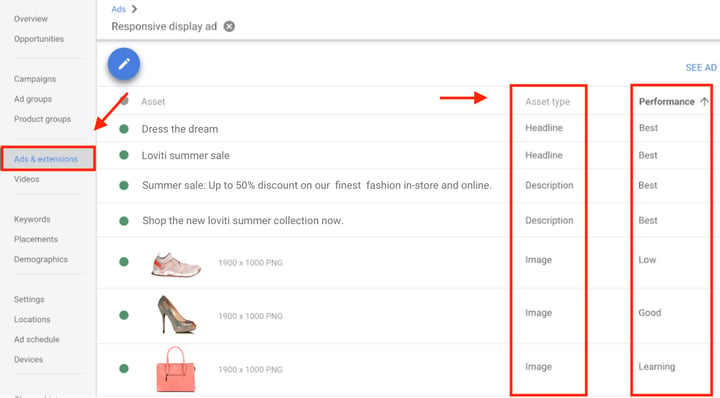When Deciding Between Responsive Display Ads and Uploaded Ads
The pros and cons of Responsive Display Ads
Responsive Display Ads sound uncomplicated to create and might deliver results in some cases; just like any other format, they too have their downsides. Before jumping on the bandwagon and allocating fourth dimension and resources to RDA campaigns, it'south essential to sympathize if they can work for you. Do the benefits of RDAs overcome the disadvantages for your specific case? Are they the best fit for your entrada goals? Responsive Display Ads (RDAs), initially released in 2016 every bit an alternative to text ads, was Google's kickoff step to bridging text ads and visual banners. In 2018, Google fabricated RDAs the default format for running ads on the Google Display Network. Since their launch, Google has been advertising RDAs as a saving grace for busy marketing executives. Responsive Display Ads are Google display ads that combine visual and textual elements. They are automatically created past Google using assets that you lot, the advertiser, upload. They can be used in standard and smart display ad campaigns. To create RDAs, you upload images and copy you'd like to use and Google combines and adjusts them to fit Google Display Network specs. Do RDAs sound similar a decorated marketer'south dream? Well, they might or might not be. While the numbers published past Google might make it seem like RDAs improve the performance of display campaigns, it'due south important to take a deeper look at these numbers: how were they measured, and practice they friction match your business goals? In the end, RDAs are Google's own product that allows them to have a lot of command over campaigns on their network. And since they don't share detailed entrada results with advertisers, it'due south important to approach Google's enthusiasm almost RDAs with caution. Then, how exercise you make up one's mind if RDAs are correct for you? What are the benefits yous tin get from them and what are the drawbacks yous need to be on the lookout for? Permit'southward look at two scenarios. On the start i, y'all're a campaign manager for a mid-tier e-commerce platform who needs to create display ads to fit GDN specs but you accept limited resource when information technology comes to design or development. Conversion is not your main business organisation. Your primary focus is to increment traffic and get optics on your product with your display campaigns and branding isn't important for your company. Hither'southward how RDAs might exist a good fit for you lot: As you may exist (painfully) aware, Google Display Network supports over twenty different ad sizes. On the one hand, it's dandy when it comes to reaching potential customers, but for advertisers short of designers and developers, creating the same, or at least similar, ads in all of these required specs can plow into a time and resource-consuming battle. In this case, using Responsive Display Ads would mean you wouldn't have to practise the heavy lifting. With RDAs, you provide Google with images, logos, or videos you want to use and text y'all want to combine them with. Google then automatically combines your assets to fit GDN standards with an increasingly diverse mix of content types, devices, and screen sizes. Simply exist conscientious, you don't have any say in the combinations: so make sure all the visuals and copy you upload can exist used in combination with each other. If you think y'all lack the resource for custom display ad production and yous are happy with generic unbranded ads Google will create for y'all, RDAs can serve yous well. If you practice want to have custom branded brandish ads, however, using a template in combination with a content management platform can be as quick and simple after the initial template creating process. From a practical perspective, the more advertizing sizes you take, the ameliorate your accomplish. Every bit a dominion of thumb, you need at least the "Large Iii" (Medium Rectangle, Leaderboard, and Wide Skyscraper) to have decent exposure. If yous want to increase your reach fifty-fifty further, adding in more sizes will probable assistance. The benefit of using RDAs hither is that since it'south Google that creates the ads, your advertisement can fit any bachelor advert space on the Google Brandish Network. Your RDAs can exist shown as dynamic text every bit well as a native ad. However, this can reduce the quality of your reach. Your ads will look like they are seen by more people more often than not because they are shown in less competed for spots. And in that location is a reason those spots are not popular amidst marketeer running ads on the GDN: they don't catechumen. So, if your campaign goals are higher CTR and lower CPC and the quality of the traffic yous receive is not that important for you, RDAs might exist a good option for you. When fashion retailer Brandfield ran a exam , generic RDAs with custom branded display ads, however, customized display ads had 47% lower CPA and xi% higher conversion rate. For a way retailer with a strong brand presence like Brandfield, customization paired with thorough testing proved to exist much more benign for optimizing their campaign and generating the best results. You tin can add branding and persuasion elements to your ads if you choose Custom display ads over RDAs This brings the states to our second scenario. You stand for a brand whose main involvement is increasing conversions while keeping ad spend at a minimum. Your nigh important goal is to improve your campaigns' return on advertising spend (ROAS). Before yous get distracted by the shiny RDA numbers thrown around, at that place are a few things to consider. Since RDAs are created automatically past Google, after uploading your avails into the system y'all have very little say over your brandish ads. For the convenience of easily creating ads in diverse sizes, y'all basically hand over your campaign to Google's algorithm. This calls for careful consideration in a few areas. One of the biggest downsides of using Responsive Display Ads is that all of your ads volition await the aforementioned, aforementioned as each other, and same as whatsoever other company. RDAs are all built upon the aforementioned generic templates. In other words: Google doesn't create your ads any differently than those of your competitors. Especially when it comes to text ads, information technology'due south really difficult to see the difference between ane brand and the other. With a generic template, information technology'due south hard to distinguish betwixt brands and cost points Aside from the lack of branding, y'all also won't have whatsoever say in the combinations that are fabricated with your visual and textual assets. This means that your texts can randomly be paired with images, and outcome in combinations that won't catechumen or even make any sense. Another disadvantage of Responsive Display Ads is the lack of insight. When yous run a entrada with Responsive Display Ads, your ads are tested by Google for a limited amount of time to determine the optimal combinations. Later on that, Google continues to serve the ads that - according to their algorithm - perform all-time. Y'all will receive an overview of the performance of each asset, but unfortunately, the data segments Google provides are limited. The network simply gives y'all four criteria when estimating your ad's functioning: learning, low, practiced, and best. Information technology doesn't offer you any insight into which ad size, combination, or format was shown at whatsoever given time, meaning you lot have to trust Google when it comes to their judgment on serving ads. This is the telescopic of campaign data you lot will get with RDAs In sum, if you're an advertiser on a tight budget or with limited fourth dimension who wants to increase their make'south reach, Responsive Display Ads tin be a huge relief. The extended accomplish provided past using Google's own production certainly provides great benefit. Nevertheless, simply increasing reach isn't plenty incentive for many brands and advertisers. If you are a more mature brand that wants to increase conversions and continue command over your creatives, RDAs aren't the best pick. The limits on the insight you become over your campaigns and the lack of control when it comes to branding and visual avails are things to exist wary of. Despite looking like a quick and like shooting fish in a barrel solution to brandish advertising, the cons of RDA's can bear on your entrada performance negatively both in the short and the long term. Customized Brandish Ads that can give you lot more valuable insight are better suited for advertisers whose goals extend beyond sensation. Building custom ads for all your display campaigns doesn't accept to be a long and backbreaking procedure. With a creative management platform like Bannerwise, y'all tin build, scale and publish ads seamlessly. Commencement your free trial now, or book a call with one of our experts to meet how a creative direction platform can assist you better campaign performance.What exactly are Responsive Display Ads?
What are the benefits of using Responsive Brandish Ads?
Responsive Display Ads are quick to create and gear up
 Google uses the same generic template for all Responsive Display Ads
Google uses the same generic template for all Responsive Display Ads Responsive Display Ads are a good source of inexpensive traffic


The downsides of using Responsive Brandish Ads
Your display ads won't have whatever branding
If y'all take a strong make identity, or you're edifice 1, RDAs can even injure more than assistance. In the long run, lack of branding results in lower conversion rates. Generic-looking ads don't contribute to retargeting campaigns; on height of that, bad branding leads to the perception that products are of lower quality.

You won't have command over your ad combinations
Using custom display ads instead of RDAs will salve your brand from generic-looking ads and confusing nugget combinations.
 With RDAs, image and text combinations don't always make sense.
With RDAs, image and text combinations don't always make sense. You'll have less insight on campaign performance

Which one to utilise: Custom or Responsive Display Ads?
Source: https://www.bannerwise.io/blog/pros-and-cons-responsive-display-ads
0 Response to "When Deciding Between Responsive Display Ads and Uploaded Ads"
Post a Comment